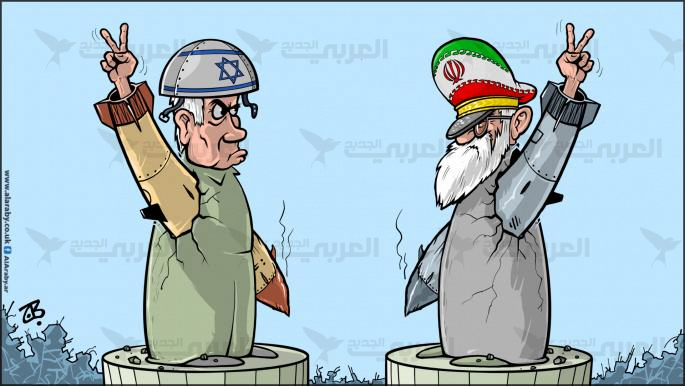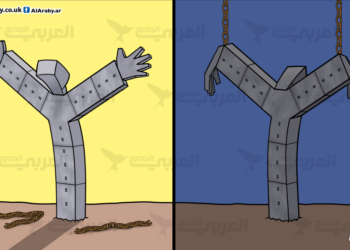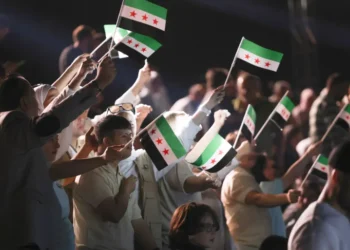The transformation of Syrian territory into an involuntary battlefield for the Iranian-Israeli conflict poses a challenge to the principles of international law. Since Israel launched its large-scale military operations against Iranian nuclear facilities on June 12, 2025, Syria has found itself at the center of a legal and humanitarian crisis, with its territory being exploited as a theater for a regional confrontation waged without its consent or authorization. This violation of its sovereignty comes at a fragile moment in the country’s history, as it seeks to navigate a post-Assad transitional phase and lacks the defensive capabilities necessary to assert control over its airspace.
The current situation embodies a legal paradox at the heart of international law: while Syria maintains its legal obligations to protect its population and prevent the use of its territory for acts harmful to other states, it has been deliberately deprived of the practical means to fulfill these obligations. This enforced incapacity resulted from Israel’s systematic destruction of Syria’s air defense systems following the fall of the Assad regime on December 8, 2024. The deliberate nature of this incapacity distinguishes the Syrian situation from traditional scenarios of state weakness or failure, raising legal questions about the extent to which sovereign obligations continue if a state’s capacity to protect is nullified by a deliberate external act.
The Structure of Erosion of Sovereignty
The principle of complete and exclusive sovereignty over national airspace, as stipulated in Article 1 of the 1944 Chicago Convention on International Civil Aviation, is one of the clearest and most established principles in international law. However, since June 2025, this principle has been systematically violated through the dual military use of Syrian airspace by Israeli and Iranian forces. These violations have gone beyond mere violations of overflight or transit rights; they have taken the form of active combat operations that have targeted and destroyed targets overpopulated areas of Syria.
Article 3(c) of the Chicago Convention explicitly prohibits government aircraft from overflying or landing in the territory of another state without prior authorization. Israel’s violations of this provision constitute a rejection of the legal framework governing international aviation, as Israel unilaterally transformed Syrian airspace into an active interception zone, thereby redefining the territorial limits of its operations and expanding the scope of its air defense to include the territory of a sovereign state.
On the other hand, Iranian forces have violated Syrian sovereignty in a different manner while launching attacks on Israel. The missiles and drones that cross Syrian airspace, leaving behind debris that sometimes falls on civilian areas, constitute a violation of Syria’s territorial integrity. This violation takes on additional legal dimensions when compared to Syria’s declared neutrality in the conflict. In theory, this neutrality, under customary international law, protects it from becoming an involuntary party to hostilities between other states. Under the law of neutrality, enshrined in the Hague Conventions and supported by legal tradition, neutral states have specific obligations in exchange for certain rights. However, Syria’s inability to enforce its neutrality (due to the deliberate weakening of its defensive capabilities) creates a legal paradox: the state remains legally bound to neutrality while being deprived of the practical means to enforce it.
Human and Economic Destruction
The transformation of Syrian territory into an active conflict zone has resulted in a complex array of civilian harms that far exceed the direct losses documented in human rights reports. Although the deaths recorded in the Syrian Network for Human Rights’ data are the most prominent feature of this harm, they represent only one aspect of a much deeper humanitarian catastrophe. Patterns of forced displacement in Daraa and Quneitra governorates reveal a pernicious form of targeting civilians. In Quneitra alone, ongoing military operations have displaced nearly half of the governorate’s population, a high percentage that indicates not a temporary evacuation but the potential for permanent demographic change.
On the economic level, the airspace isolation imposed on Syria constitutes a blatant form of economic strangulation. The repeated closure of its airspace, stemming from security concerns related to the Iran-Israel conflict, has almost completely severed its links to global aviation networks. Major international airlines have suspended flights to Syria, while high insurance costs burden regional companies, rendering their operations economically unviable.
This air blockage has exacerbated economic marginalization. Time-sensitive Syrian exports, particularly agricultural products, have lost access to global markets, and supply chains for medicines and medical supplies have been severely disrupted due to their reliance on rapid air transport. At the same time, business travel has become virtually impossible, depriving Syrian companies of opportunities for international partnerships and investment.
The effects of stalled reconstruction efforts and declining investments are among the most profound long-term economic consequences of Syria’s forced transformation into a conflict zone. The fall of the Assad regime in December 2024 sparked a wave of cautious optimism among international development agencies and donor countries, accompanied by initial commitments to support reconstruction efforts and infrastructure investment. However, the escalation of the Iran-Israel conflict quickly dispelled this optimism, transforming Syria from a reconstruction arena into a dangerous zone.
Development projects require a degree of time stability—the ability to set long-term timelines, predict security conditions, and ensure the safety of personnel and facilities. In the absence of these requirements, donors and investors are unable to implement their plans, leading to a near-paralysis in development operations and widening the economic and social gap facing Syrians.
Legal Accountability in an Asymmetric Framework
The Syrian government faces a legal paradox: it is required to fulfill international obligations, including protecting its population and preventing the use of its territory to carry out acts harmful to other states, while systematically depriving itself of the means necessary to fulfill these obligations. Under international human rights law, particularly the International Covenant on Civil and Political Rights, Syria has an inalienable obligation to protect the right to life of all persons within its territory. The Human Rights Committee has interpreted this obligation as encompassing three distinct duties: to respect (refrain from violating rights), to protect (prevent third parties from committing violations), and to fulfill (create conditions that enable the enjoyment of these rights). While Syria remains capable of fulfilling the first duty, fulfilling the second has become virtually impossible, as preventing Israeli aircraft from carrying out military operations over Syrian cities or intercepting Iranian missiles crossing its airspace requires an air defense infrastructure that was systematically destroyed by Israel in December 2024.
In this context, the diplomatic protests that the Syrian government must continue to lodge acquire legal significance that goes beyond political expression. Under customary international law, a state’s silence regarding violations of its sovereignty can be interpreted as acquiescence or concession. Therefore, Syria’s repeated protests are vital legal tools that go beyond symbolic expressions, preserving its right to seek compensation in the future and preventing any interpretations that might indicate tacit approval of violations. The Syrian government’s repeated condemnations of what it describes as “flagrant violations of sovereignty” are not merely political statements; they represent essential legal measures to ensure the continuity of its demands for redress when appropriate circumstances arise.
Maintaining the legal effectiveness of these protests requires specific elements: formally addressing them to the violating states, registering them with relevant international organizations, and maintaining a pattern of protest that leaves no room for ambiguity regarding the Syrian state’s position. Although these protests have not led to an immediate cessation of violations, they play a central role in preventing the crystallization of any alleged right to use Syrian territory for military purposes by external parties. These protests also serve as a documentary record for any future legal proceedings, whether through international courts or diplomatic channels.
Regular diplomatic protests are a prerequisite for potential recourse to international judicial mechanisms in the future. Should Syria later decide to bring cases before the International Court of Justice or other judicial bodies, demonstrating a serious attempt to exhaust diplomatic solutions would significantly strengthen its legal position. Thus, the current commitment to protests, while not achieving any immediate results, constitutes a legal basis that enables Syria to seek redress later and prevents the erosion of its legal rights through silence or the passage of time.
Institutional Paths and Their Limits
The pursuit of legal accountability through international institutions reveals a clear discrepancy between the theoretical robustness of the international legal system and its practical limitations. Syria, in theory, has multiple options, ranging from the UN Security Council to specialized international agencies, each offering distinct legal capabilities but facing its own limitations.
The Security Council is the most prominent of these forums, though also the most subject to political considerations. Under Chapter VI of the UN Charter, the Council has broad powers to investigate disputes and make recommendations for their peaceful settlement. Syria used Article 35 of the Charter to refer the situation to the Council, creating an official record of violations and forcing member states to publicly acknowledge them. However, the Council’s ability to take effective action is hampered by serious obstacles, such as the use of veto power by permanent members and competing geopolitical interests, which transform legal issues into political files subject to bargaining.
Despite these obstacles, the Security Council retains important functions within Syria’s long-term legal strategy. Presidential statements and press releases, while non-binding, constitute official documentation in the UN records that can be relied upon in the future. Council discussions also require member states to disclose their legal positions, which may limit their ability to maneuver later or create precedents that can be used in other forums. More importantly, the Council’s continued inability to address clear violations of sovereignty and international law reinforces calls for its reform or the creation of alternative mechanisms, contributing to the long-term development of the international institutional architecture.
On the other hand, the International Court of Justice offers a more rigorous legal path, albeit one that is conditional and procedurally restrictive. The direct judicial path requires the consent of all parties involved, a consent unlikely to be provided by Israel or Iran. However, alternative paths remain. Syria can, through the UN General Assembly, request an advisory opinion from the court on the legal consequences of repeated violations of its sovereignty and the obligations of third states in this context. Article 84 of the Chicago Convention provides another entry point, allowing for the referral of disputes related to civil aviation to the court, which could contribute to establishing legal precedents regarding the use of neutral airspace for military purposes.
Although the Court’s advisory opinions are not legally binding, they have a profound impact on the development of international law and guide the conduct of states. An advisory opinion issued by the Court regarding the disruption of a state’s defensive capabilities or systematic violations of its sovereignty can fill important legal gaps and provide legal support for Syrian claims. The Court’s fact-finding and legal analysis capabilities also lend significant credibility to the Syrian record and serve immediate advocacy efforts and long-term judicial endeavors.
In addition, the diversity of specialized international agencies provides additional forums, although they often lack direct enforcement powers. The Council of the International Civil Aviation Organization (ICAO) has mandatory jurisdiction to hear disputes arising under the Chicago Convention, giving Syria a means to challenge repeated violations of its airspace without requiring prior consent from the violating states. The ICAO’s decisions carry particular weight due to their relationship with the civil aviation sector and their impact on insurance markets, which can result in indirect economic costs for violating states through increased risk assessments and reduced air operations.
Syria’s interaction with multiple institutional forums creates what is known in legal literature as “regime complexity,” a concept that refers to the overlapping of different legal powers and mechanisms that provide multiple, simultaneous pressure points for accountability. This multi-platform strategy is a partial means of compensating for the limited effectiveness of any single institution and accumulating increasing institutional pressure to achieve some form of accountability.
In contrast to this institutional diversity, the limited availability of avenues reveals deeper structural crises plaguing international law enforcement mechanisms. The absence of compulsory jurisdiction, political hegemony over enforcement decisions, and the international system’s lack of effective mechanisms to address power imbalances are all clearly evident in Syria’s struggle for reparations. However, these limitations should not obscure the important role played by international institutions in documenting, setting standards, and creating political costs. Even when these institutions fail to provide immediate solutions, they contribute to establishing legal norms and generating political effects that influence state behavior over time.






